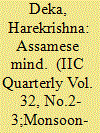| Srl | Item |
| 1 |
ID:
067842


|
|
|
| 2 |
ID:
103563


|
|
|
| 3 |
ID:
135437


|
|
|
|
|
| Summary/Abstract |
In 1972, the map of Assam changed and its size shrank. While the two valleys remained together, the hills saw emergence of several States. The country soon had to invent a new metaphor to give the new map a
new image after cutting it into parts and then re-joining it into a new composite whole. Instead of referring to the new States separately, the Centre started calling the region by a geographical directional name "North-East." Then in 1976, in the Congress session held at Guwahati, the Assam Chief Minister, Sarat Chandra Sinha, introduced a new metaphor "Seven Sisters" to describe the region. His purpose was to stress the common economic destiny of the seven territorial units of the region and thereby dispel misunderstanding between Assam, the largest State, and the smaller ones, all members of the North-East Council. The metaphor was not simply used in the context of border disputes between Assam and Nagaland as stated by the veteran journalist, Satish Chandra Kakoti1, though it was in the background. The metaphor "Seven Sisters" was not Sinha’s own invention. In 1972, Jyoti Prasad Saikia, then working as a journalist for The Times of India and based at Agartala, first used this description for India’s North-East in a radio talk he delivered on the occasion of the inauguration of Tripura State. Saikia later joined Sarat Chandra Sinha’s personal staff as a press secretary (he was to become a member of the Indian Administrative Service in Assam cadre in later years). Indira Gandhi endorsed this description while addressing the youth convention in the AICC session at Guwahati (then Gauhati) and later the central leaders eagerly appropriated the idea so as to give the region an integrated image. But to understand the compulsion behind the act of dismemberment of a State and the attempt to conceal its broken look, we need to follow the political developments in Assam after India’s independence.
|
|
|
|
|
|
|
|
|
|
|
|
|
|
|
|
| 4 |
ID:
164376


|
|
|